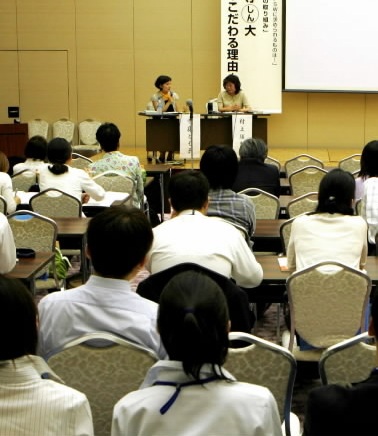A-bomb Microcephaly: The Lives of Patients, Part I [5]
Jun. 29, 2010
Aging parents cannot provide support, patients need life-long security
by Masaki Kadowaki, Staff Writer
When a woman is exposed to a high dose of radiation in the early stage of pregnancy, the baby's head can be abnormally small in size, resulting in mental and physical disabilities. The condition is known as A-bomb-caused microcephaly. The Ministry of Health, Labour and Welfare has granted official certification to 22 patients of this disease (as of the end of fiscal 2003). Many of the patients and their family members hoped to increase understanding of the condition, but at the same time, have felt fear of encountering prejudice and so wound up withdrawing to the margins of society. Sixty years have passed since the atomic bombing. [This series was originally published in July 2005.] Before the memories borne of that day fade, let us pass on the experiences of the bombing by tracing the personal history of one family affected by microcephaly.
Last spring, the mother, 84, and her microcepalic daughter, 59, moved to a small welfare facility in Hiroshima where people with mental disabilities live and/or work. Almost ten years have passed since they moved from Kitakyushu. The daughter very much enjoys working at the facility and swimming in a local pool twice a week.
With a loving look at her smiling daughter, the mother said, "She's always been good at making friends."
The mother, though, has had difficulty with discrimination. She has found that Hiroshima residents have a better understanding of A-bomb survivors. Still, their attitudes toward her daughter are not much different from those in other places. The monthly allowance from the government for microcephalic patients can even cause friction with regard to other disabled people.
In this connection, when the mother is asked the difference between her daughter and another disabled child, she feels at a loss for a reply. Radiation destroyed her daughter's brain cells while she was still in the uterus, and her daughter must still contend with anxiety over the potential aftereffects. The mother said, "To be honest, I want to tell them that my daughter is different, though the circumstances appear the same as those of other disabled people."
Nineteen years ago the mother took a fall and, since then, has had to walk with a cane. Moreover, she has suffered from a brain tumor and was certified as being in need of nursing care. But she will not make use of the services of home-care workers or nursing care insurance programs. She has taken pride in raising her daughter on her own, and cannot now bring herself to rely on others.
The Mushroom Club, which consists of microcephalic patients and their families, has not been very active of late. In 1967, the club moved the national government to recognize the relationship between the atomic bombing and the patients' disease, and won financial support. However, they have not gained life-long security, something they have also demanded. But many of the patients' parents have died, and the average age of those still alive is almost 88. Some of them are now bedridden. This is the stark reality.
The daughter was certified as a microcephalic patient by the national government 16 years ago. She obtained certification later than most patients, but she was not the last. The Ministry of Health, Labor and Welfare certified one patient in December last year. But the identity of the patient has been concealed to preserve the individual's privacy and it was not disclosed to the Mushroom Club.
Sugako Murakami, an expert in medical welfare and a professor at Ube Frontier University in Yamaguchi Prefecture, has been leading a group for more than 20 years which provides support to the Mushroom Club. She raised the question: "The bombs were dropped as the final blow in the war initiated by the national government. As a result, microcephalic patients were born. But has the government done enough for them?"
Tomoko Saito, 44, is an actress and a member of the support group. She attended a meeting to discuss the future of microcephalic patients in early June in Hiroshima, and told some 150 participants: "A candle will eventually burn out, but before the flame wanes, you can put the flame to another candle, and to another."
The mother thought deeply about the actor's words and walked out of the meeting room with her cane. The daughter followed along closely behind her mother.
(Originally published on July 15, 2005)








